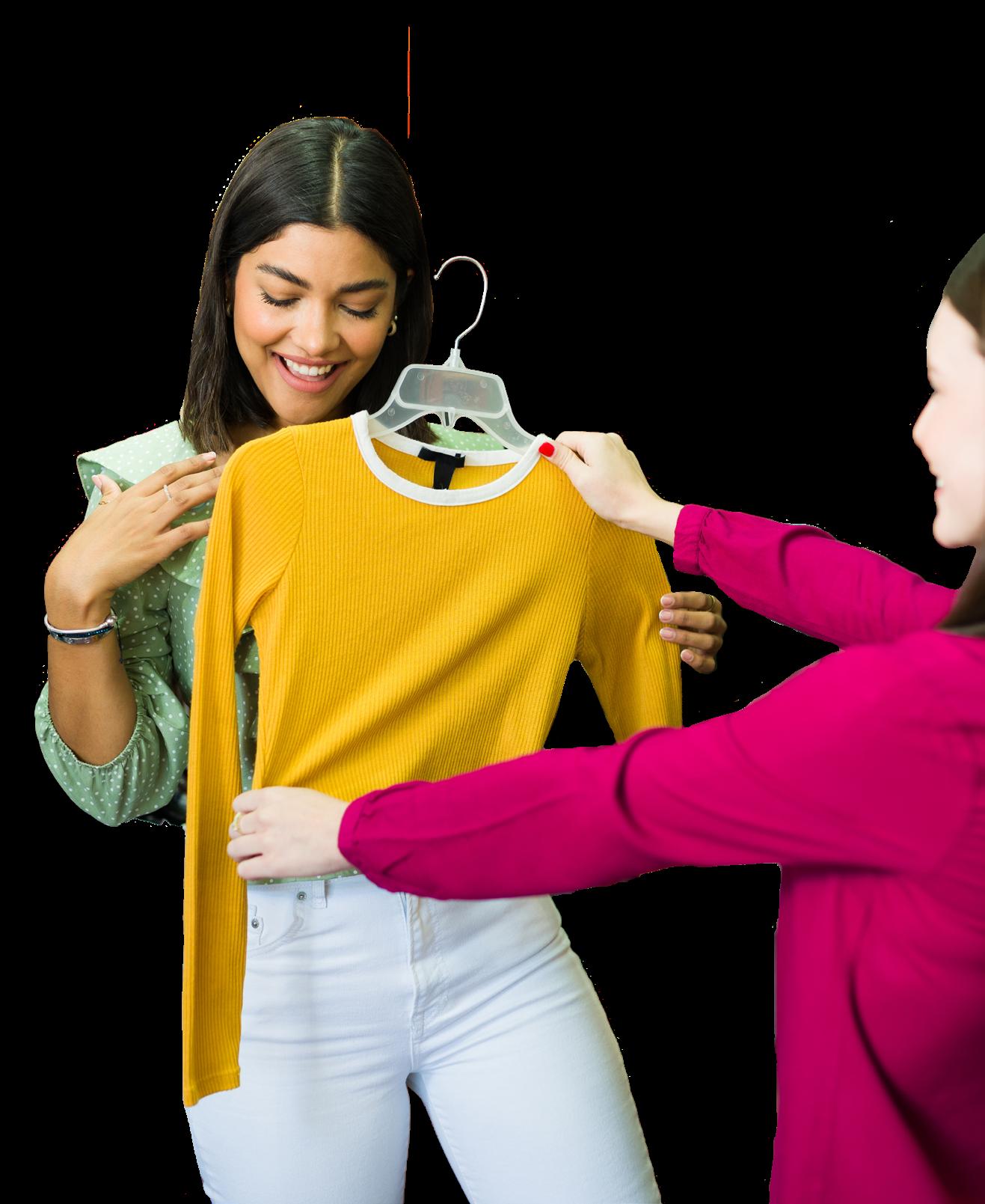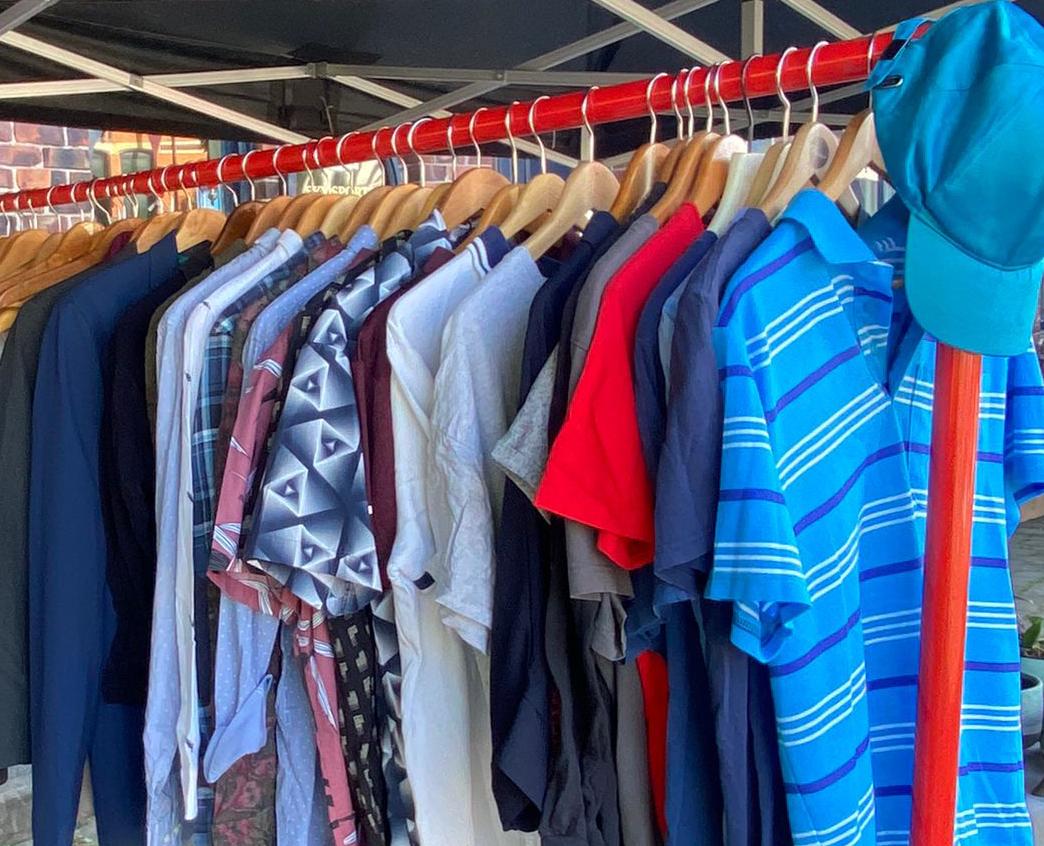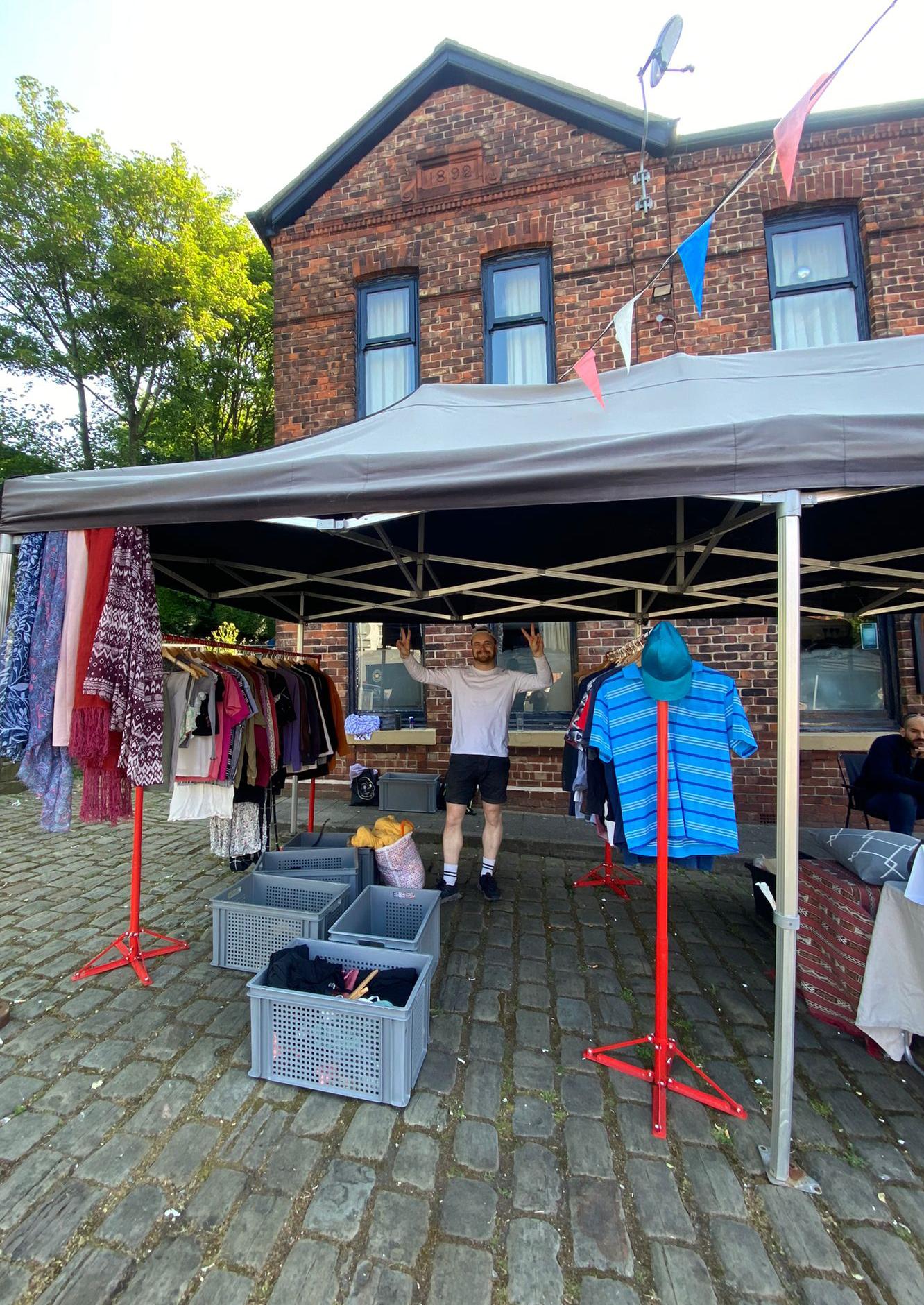










At Future Fashion Fair, we’re passionate about promoting sustainable fashion practices and helping consumers make more conscious choices.
One of the biggest impacts of the fashion industry is the amount of clothing we buy and the environmental and social costs associated with producing and disposing of these items.
In the UK alone, we buy an estimated 1.13 million tonnes of new clothing every year2 — most of which goes to landfill.
That’s where swap shops come in. By participating in clothes swaps, we can extend the life of our clothes, reduce textile waste, and save money. Not only that but swapping clothes is also a great way to connect with others and build a sense of community.
Sharing and repairing clothes isn’t anything new. We’ve been doing it since the dawn of time - passing down clothes through family and friends, sharing hand-me-downs between siblings, and borrowing outfits from our besties.
Our swap shop toolkit will guide you through the practical tips and best practices to help you organise your own clothes swap event in your community, alongside information about the benefits of clothes swapping and a circular economy.

Research shows that people in the UK purchase an average of 26.7kg of new clothing each year3, only wearing about 44% of our wardrobe regularly.4
This means that most of our clothes become unused, unloved, and eventually thrown away. Clothing that is thrown away takes an average of 200 years to decompose, and as it does, it releases harmful chemicals into the earth and greenhouse gases into the atmosphere. This has a detrimental impact on the environment and contributes to climate change.
Fashion usually takes a traditional linear approach to production and consumption where resources are taken from the earth, turned into products, and then discarded as waste. This approach creates a “take-make-dispose” cycle, where products are designed to have a short lifespan, resulting in significant environmental degradation and resource depletion.
The main problem with a linear economy is that it is not sustainable in the long term. As the population grows and resources become scarcer, the linear economy model becomes increasingly unsustainable. It contributes to climate change, pollution, and the depletion of natural resources such as water, energy, and minerals.

Enter the circular economy.
The Circular Economy is a system that aims to eliminate waste and keep resources in use for as long as possible, through strategies such as recycling, upcycling, and reusing. This approach reduces the strain on the environment, encourages sustainable production and consumption, and creates economic opportunities by developing new business models and supply chains.
Clothes swapping is a crucial part of this system as it helps to extend the life of clothing items and prevent them from being thrown away. By participating in clothes swaps, we’re reducing the amount of clothing waste that ends up in landfills and conserving valuable resources.
It’s a common misconception that donating our unloved clothes to charities is the ultimate solution. While it’s a noble act, it’s not a silver bullet to the problem of textile waste. Charities often receive more clothes than they can handle and are not equipped to handle the sheer volume of donations. As a result, they often sort and ship the excess clothing to countries in Eastern Europe and Africa where they are sold at local markets. This has a negative impact on the local textile industry and economy and often leads to a surplus of unsold garments that end up in landfills, contributing to the already mounting waste problem. For example, in cities like Accra, Ghana, piles of clothes are a common sight and a clear indication that the current system is not sustainable.5 We need to find better solutions for dealing with textile waste, and clothes swapping is a great place to start.

Clothes swapping is a less impactful alternative to buying new clothes or donating clothes to charity. It involves people exchanging their unwanted clothes with others, giving them a new lease on life, and reducing waste. Clothes-swapping events can take various forms, from in-person events to online platforms, and can be organized by individuals or groups!
Swapping clothes is an increasingly popular trend and for good reason. Not only does it offer a sustainable alternative to buying new clothes, but it can also be a fun way to refresh your wardrobe and connect with your community. However, for swapping clothes to be truly beneficial it must be available to everyone, regardless of cultural background, community, gender, or age. Here are some ideas to consider when it comes to making clothes swapping accessible and inclusive.
Sharing and swapping clothes are two different concepts, with unique benefits. Sharing clothes is often a more casual, flexible exchange, where garments can be borrowed or passed on without any immediate return. It’s like creating a system of give and take within your network, which can be built in many ways - from lending to friends and family to participating in online social groups or community centres.
Swapping clothes on the other hand, is a permanent exchange. You give your item away forever, and get one of equal value in return. An easy way to facilitate this in your life is a swap shop!
When it comes to building a community, network or group for clothes swapping, there are several factors to consider...
Swapping clothes can help to build stronger communities by fostering relationships between individuals and promoting social interaction. This can be especially valuable for marginalised communities or communities that are geographically isolated. A successful swapping program will require active participation from its members and a strong sense of community.
It’s also important to promote diversity and inclusivity within the community. Swapping clothes can help to promote diversity in fashion by exposing people to clothing items they may not have had access to otherwise. This can be especially valuable for people who want to experiment with new styles or who may not have access to a wide range of clothing options.

“Kids grow out their clothes so fast and can be expensive to replace, being able to swap is a double win!”
- Mum of 3 kids
“Great to see less impactful ways of rotating your wardrobe!”
- New swapper


“It’s exciting to give away clothes I no longer wear and swap them with something new with having to buy new!”
- Experienced swapper


example of how swapping and sharing clothes can connect communities or different people outside of groups to circulate clothing is through a neighbourhood clothes swap event. This event could be organised by a community group and advertised to the wider community, encouraging people to bring clothing items they no longer need and exchange them for items that others have brought. By bringing together people from different backgrounds and neighbourhoods, this event can promote community building and reduce waste, while also giving people the opportunity to find new clothing items that they may not have had access to otherwise.
Clothes swapping can be enjoyed by all people, but it is important to create an event that is appropriate for different age groups, genders, religions, and social classes. It is important to create a safe and welcoming space for people of all ages to participate in clothes swapping. Embracing cultural differences can be an excellent way to do this, as it can bring new perspectives and experiences to the group, ensuring there is variety at these events will help make it more inclusive.
Different cultures have different attitudes towards clothing and fashion. It is important to be sensitive to these cultural differences when organising clothes swaps. For example, some cultures may not approve of wearing second-hand clothes, while others may have specific requirements when it comes to modesty. It is important to create a safe and welcoming space for everyone to participate in clothes swapping, regardless of cultural background.
Clothes swapping can be a great way to save money and reduce the negative impact of fast fashion, but it is important to make sure that it is accessible to people of all socioeconomic backgrounds. This may mean organising events in neighbourhoods and providing financial assistance for people who cannot afford to attend.
Swapping and sharing clothes can save people money, as they can acquire new clothing items without having to buy them. This can be especially valuable for people who cannot afford to buy new clothing regularly.
‘Swaps’ should be accessible to everyone, regardless of physical ability. This means ensuring that the venue is wheelchair accessible, that there are no barriers to entry, and that there is adequate space for people to move around.
Consider the costs and structure of the swapping program. This includes everything from how the clothes will be exchanged to the rules and guidelines that will govern the process. A well-structured and organised program will be more likely to succeed and meet the needs of its members.
To make clothes swapping accessible and inclusive for everyone, it is important to consider the unique needs of different cultures, communities, genders, and ages. By creating a welcoming and inclusive space, we can encourage more people to participate in clothes swapping and help reduce the negative impacts of fast fashion on the environment.
Considering these when creating a swap, can create clothes swap events that are truly accessible and inclusive and help to reduce the negative impacts of fast fashion on the environment and our communities.


How minimal you make your swap shop is up to you. If you’re just swapping amongst friends you really don’t need any equipment, but if you’re wanting to organise an event, then you’ll need the essentials.
Our essentials for running an organised event:
Clothing rails Hangers
Box(es) (some form of storage for your clothes)
Table and chairs
We normally organise clothes by item type (tops, dresses, trousers etc.) on hangers and rails. This makes it easier for people to see each item. But, if you were running something more casual you could divide different types into boxes or even piles on your bedroom floor. As well as item type, you could also organise clothes by size, colour, material or weight - it’s all down to what works for you and your swappers!
It’s also good to have a box or two for excess clothing when you run an event, in case you get items faster than you can hang them up! To make stock more manageable - we recommend limiting the number of swaps to 10 per person.
A table and chairs is a staple for our organisers, this provides a central point to the swap shop where staff or volunteers can greet swappers, assess clothes and facilitate swaps. It’s also a good place to display accessories or items you can’t hang up.
That’s about as basic as you can get. If you want to jazz your swap shop up a bit, consider bringing a speaker to play some music and adding some fun decor! An extra bonus is also some kind of changing facilities, so people can try on items before they take them home. This reduces the chance of people taking items they won’t use and keeps them in the loop for somebody else to enjoy.
A trading system is a way to categorise garments by ranking them. Clothes could be ranked by cost (high street, mid-range and designer), usability (everyday pieces vs unique finds), or weight (light items like a thin cardigan vs heavier ones such as winter coats).
Organising items into categories like these means people can swap clothes with items of equal value. For example, it wouldn’t seem fair swapping a plain white t-Shirt for a down jacket because they are typically of such different value.
You can then name these groups and label items respectively in the swap shop. We suggest no more than three categories to save things from getting too complicated. The groups could be called bronze, silver, gold; good, better, best; new with tags and worn; or simply low-end and high-end. It’s up to you, it’s just so that people know what tier an item is in.
When someone brings in clothes to swap, your staff or volunteers will assess the items of clothing to decide what category they are in, and then label the items respectively. The swapper then receives tokens - these can be virtual or physical - but we recommend virtual for efficiency and waste reduction.
These tokens can be exchanged for other items in your swap shop.
If someone brings in two bronze items and one gold - they would generally leave with two bronze items and one gold. You can make it more flexible if you’d like, for example, one gold item equals 5 bronze items, but how you do that is up to you.
General rules:
• Check clothes for stains and holes - ensure the clothes you accept into the swap shop are good quality and re-wearable
• The simplest trading system is a 1 for 1 principle (e.g. one gold item for one gold item)
• Limit the number of items people can bring to keep stock levels manageable - we advise 10 per person
• Allow people to roll over tokens for your future eventssometimes people don’t find items that they want to swap for on the day
Anywhere can be a venue for a swap shop! You can use your garden at home, a youth centre or a communal space at work. Wherever you can get together with your local community and bring your clothes will do. You should make sure your venue has disabled access to make your swap shop as inclusive as possible.
If you’re wanting to hire out a space for a more formal event - it really depends on what you’re going for. The main thing you need is an open space where you can display the clothes, for example, a community hall or events space. It doesn’t have to be big or fancy. You want to make sure it’s commutable by public transport and has parking spaces nearby. Disabled access is also a priority to ensure your swap shop is as inclusive as possible.
Other things to look for in your venue are toilets (which can also double as changing rooms), and a bar if you want to serve refreshments. You want to make sure the space is welcoming, organised and fun - the longer people stay, the better the atmosphere and the more successful the swapping!

If you’re organising a swap shop between friends in a casual setting, you don’t need any staff. As long as everyone involved is aware of the trading system, you can monitor it amongst yourselves.
We typically have around three people to run a swap shop event. One volunteer will take the clothes and check they’re of an acceptable standard, another will process the items within the trading system (e.g. awarding three bronze tokens to the swapper), and the last will hang up new clothes for the swap shop and make sure everything keeps organised.
If you have volunteers running your swap shop, make sure you brief them all on their roles ahead of the event. As well as their roles, explain to them how to set up and pack down and leave the venue as they found it. This prevents any confusion - and if you’re the organiser and you’re not attending the event - make yourself contactable in case of emergencies.
Overall it should be a fun day for both swappers and those staff and volunteers who are running the swap shop!




At Future Fashion Fair, we are proud to host a variety of swap shops aimed at promoting conscious consumption of fashion. One of our popular events is held at The Yard, where we aim to make clothes swapping accessible to everyone. With no entry fee, we encourage people to participate in the swapping and donating process. Our goal is to ensure that all clothes are swapped or utilised correctly, even if they are not swappable.
To ensure a smooth operation of the swap, we value clothes in three categories: bronze, silver, and gold. Once swappers have had their items checked, they are able to exchange them for other clothing items of equal value. To support the operation of the swap, we take a small £1 service fee for each swap.
Despite being a small-sized swap shop, we have been able to attract a large number of participants who appreciate our commitment to sustainable fashion practices. Our volunteers are instrumental in the success of our swap shop events, with one volunteer collecting the swaps and another assisting with swappers’ requests and maintaining the general upkeep of the shop.
We sort clothes based on quality and condition, with bronze being the lowest and gold being the highest. This helps swappers to understand the value of their clothes and encourages them to bring items in good condition so they can swap with like for like product. It also makes it easier for swappers to find items that meet their standards.
We also have clear guidelines for what can and cannot be swapped. This will help to manage expectations and reduce any confusion or disappointment. We ask that products brought in for swapping do not have any major defects which make the product undesirable, we also don’t accept certain items like swimwear or undergarments for hygiene reasons.
Finally, we recommend having a plan in place for the disposal of any items that are not swapped. This ensures that the event is not only about swapping

but also encourages sustainable disposal of clothing. The donated items can be given to charity or recycled correctly.
Running a swap shop can present some challenges, one of which is the quality of the products being swapped. As items are donated, it is possible to encounter items that are not in the best condition or may not be of interest to other swappers. This is where valuing products becomes important. By categorizing items based on their quality and relevance to the target audience, you can ensure that the swap remains consistent in terms of the standard of products being offered. It is important to make fair evaluations of products to maintain trust with swappers and encourage them to continue participating in the swap shop. Encouraging swappers to donate items that are still in good condition and relevant to the target audience can also help to maintain the quality of the product offering.
FFF Swap Shops have been a success in promoting sustainable fashion and encouraging conscious consumption. Despite the challenges we face in ensuring the quality of the products and maintaining a consistent standard, our swap shop remains adaptable and flexible for different occasions and environments. We can offer free swaps for when focusing on accessibility and affordability, or create ticketed events and invite collaborative brands for customising swaps, making it more engaging and fun. Our goal is to make swapping an easy and enjoyable experience while promoting sustainable practices and textile-reducing waste. As swap shops become more common, these models will adapt and evolve, but whatever your aim, it’s about having fun with it!
1. WRAP (2020). Valuing Our Clothes: The Cost of UK Fashion Retrieved from https://wrap.org.uk/sites/default/files/2020-10/WRAPvaluing-our-clothes-the-cost-of-uk-fashion_WRAP.pdf
2. Wrap. (2018). Sustainable textiles: market situation report. Retrieved from https://www.wrap.org.uk/sites/default/files/2018-11/WRAP_ Sustainable_Textiles_Market_Situation_Report_2017.pdf
3. WRAP. (2017, July 19). Nation’s wardrobes hold £10 billion worth of unworn clothes, as people open new accounts to buy more. WRAP. https:// wrap.org.uk/media-centre/press-releases/nations-wardrobes-hold-16billion-items-unworn-clothes-people-open-new
4. WRAP (2012). Valuing our clothes: The true cost of how we design, use and dispose of clothing in the UK. Available at: https://wrap.org.uk/resources/report/valuing-our-clothestrue-cost-how-we-design-use-and-dispose-clothinguk-2012
5. Textile Mountain Film Festival. (n.d.). About. Retrieved from https://www. textilemountainfilm.com/about.



